Proven for over 20 years and Made in Norway
DreamScreen home theater screens
DreamScreen is a Norwegian brand of advanced AV equipment. Founded in 2002 in Oslo, Norway, we have spent many years developing and distributing products in the advanced audio and video segment, including studio quality screens, furniture and soundproofing products. Our main focus has always been to provide DIY quality and complexity at custom installation levels directly at lower prices, so that hi-end XXL cinema would be possible for an even larger group of (awesome) people. After all, we are also true AV enthusiasts!
More is not possible: DREAMSCREEN ULTRAFRAME and ULTRAWEAVE now in the German specialized trade with us:
While Dreamscreen’s focus is certainly on providing a full range of specialty items – from construction to outfitting your theater – the acoustically transparent screen is probably one of the most critical components in a modern high-class theater and can cripple both sound and image. Dreamscreen found that suppliers simply weren’t able to deliver the quality this segment deserved, and Dreamscreen began developing their own line of acoustically transparent screen fabrics more than twenty years ago. The current generation of fabrics uses a brand new method: multiple reflective layers. To achieve this, Dreamscreen has spent year after year researching and consuming tens of thousands of yards of fabric. As a result, Dreamscreen has patented the technique in all major markets, including the EU and the USA.
ARLED Solutions GmbH, respectively ARLED Cinema, is proud to be a part of the Dreamscree family. As a retail partner for Germany you can get Dreamscreen products exclusively from us.
Newly available!
Ultra Weave StudioX1
The patented multi-layer system ensures an ultra-fine front surface, that of a normal, non-acoustic, transparent coating.
That means you can sit as close as you want without being distracted by visible textures. The ultra-matte finish also means the reflected image is free from glare, smudges and other artifacts that other materials might create.
Due to the random placement of the primary reflective layer, moiré does not occur with any projector technology or resolution.
The integrated black back panel effectively blocks reflected light from speakers or other reflective objects located behind the screen.
Patented in major markets around the world for outstanding cinema experiences
Dream Screen Ultra Weave
For the development of the 7th generation UltraWeave, Dreamscreen had a clear mission!
Use the patented multi-layer principle to increase gain levels to the absolute maximum possible while maintaining the ultra-matte properties of a perfectly functioning Unity Gain screen. At the same time, the goal was to keep the acoustic transparency at the highest possible level.
The solution to this challenge was to add another custom reflective layer and increase the number of layers from 3 to 4. A front ultra-fine woven layer and three layers of knitted fabrics in various layouts and configurations. Everything is custom-made, right down to the thread diameter and the carefully coordinated look of each layer.
While each layer does its own job, all the layers add up to provide the award-winning properties of any Dreamscreen screen – true innovation from The Power of 4!

Technical data
Cloth size: 2.3 x 4m and 2.3 × 5.3m
- Gain (D65 benchmarked): 0.9
For resolutions up to 8K. Zero moiré guarantee at any resolution
Incl. wall bracket and accessories
Other image sizes and formats always possible on request

| Gain (D65 benchmarked) | 0.9 |
| Acoustical Transparency | 3,3dB average loss |
| Viewing cone | 160° |
| Reflection | 100% matte unity gain principle |
| Supported resolutions | >8K. Zero moiré at any resolution |
| Buildup | 4 layered bonded weave + knit (patented) |
| Black backing | Integrated |
| Fire retardant | Yes, US NFPA 701 certification |
| Available sizes | 2,3x4m and 2,3×5,3m rolls |
| Available accessories | Universal fabric grip rails
Fabric installation tool Regular and motorised masking frames |

INNOVATION BY THE POWER OF 4
For the development of our 7th generation UltraWeave we had a clear mission;
Utilise our patented multiple layered principle in order to increase gain levels to the absolute possible maximum while still retaining the ultra matte characteristics of that of a perfectly performing unity gain type of screen. At the same time our goal was to keep the acoustical transparency at the highest possible level achieving this.
Our solution to this challenge was adding yet another custom designed reflective layer, increasing the amount of layers from 3 to 4. One front ultra-fine woven and three layers of knitted fabrics in different layouts and configurations. Everything is custom made down to the thread diameter and carefully tuned appearance of each layer.
While each layer has a mission of its own, it is through the interaction with the other layers its inherit potential is revealed – true innovation by The Power of 4!

UNPRECEDENTED UNITY GAIN LEVELS
The v7 increases gain from our 6th generation fabrics by 16%, with an official D65 benchmarked gain value of 0.93 from 0.80 on our v6 fabrics.
A solid, non acoustical transparent screen based on a unity gain principle will never surpass a gain value of 1.0, meaning the v7 deducts <10% of the light while still remaining highly acoustically transparent. This is comparable to the gain level one might expect from a micro perforated 1.0 unity gain vinyl screen, but without the drawbacks such as highly visible perforations and far lower acoustical transparency. It is also comparable to the highest gain woven screens, but without the use of a coarse, potentially visible woven structure that might also cause moiré.
One important note on gain levels is that, unfortunately, many manufacturers tend to inflate their official figures far beyond reasonable levels. We have therefore taken professional measurements, performed by a THX / ISF professional, benchmarked using the one screen fabric we are confident provides accurate figures; the industry standard Stewart Studiotek 100 (our favourite non-acoustical transparent screen material by the way).
We have compared the gain of the Studiotek 100 to a woven screen stated to be 1.1 gain by the manufacturer. Our measurements indicate an actual gain of 0.86, i.e. inflated by more than 20%.
All measurement raw data is located at the bottom of this page.

A unity gain type of screen like the UltraWeave v7 reflects incoming light in all directions, creating perfect image uniformity. This ensures that the image appears perfectly lit throughout the screen area for the entire audience, becoming increasingly important nowadays as screens size increases in relation to seating distance due to 4K resolutions and above becoming the norm, plus of course, an ultra-fine screen fabric such as the v7 allows for the increased impact of a more immersive video experience.

Example of how a glossy screen coating might produce a sheen (and potentially also speckle), compared directly to the v7. There are actually a number of 1.0 gain (or lower) screens that has this shimmer applied to its coating as well, whereas this particular fabric is a regular 1.0 gain PVC non-AT variant. For positive gain or filtered screens, this effect might be far more visible than this example. This issue is typically visible on brighter images, and particularly noticeable on moving camera shots (pans / tilts). What you see instead of the projected image is the actual screen structure appearing overexposed, highly reducing the quality and also peak luminance details when visible, caused by the burned out peaks. The v7 is, however, completely matte and follows the unity gain principle, never allowing for these types of artefacts reducing the performance of the projected image.
ULTRA-FINE SURFACE DENSITY
The v7 allows for seating as close as 1m / 3ft distance without any visible structure from either perforated holes or coarse weaves distracting you from enjoying the displayed content.
A coarser woven screen will also run the risk of producing moiré, especially once resolutions increase to 4K, 8K and beyond moving forward. Moiré might also occur as a consequence of changing the projection technology, such as moving from D-ILA to a lower pixel density DLP or LCD (even at the same resolution). As people tend to keep their screens longer than they do their projectors, investing in a v7 screen fabric would ensure that moiré will never occur – at any resolutions – ever. This is due to the extremely tight, randomised front woven surface layer of the v7, emulating the coating of a non acoustical transparent regular screen.
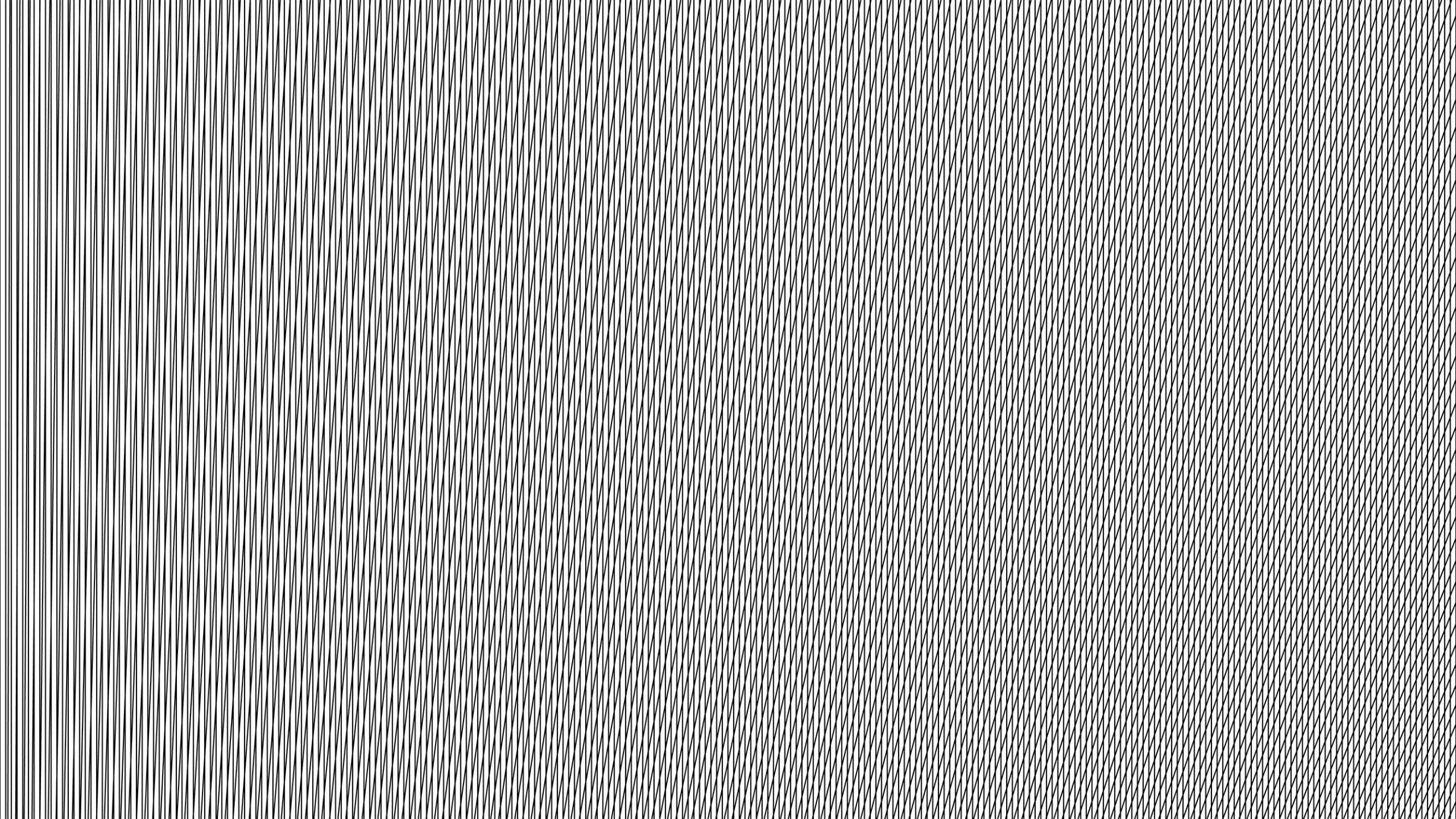
This is an example of moiré, a phenomena occurring if pixels from the projector interlock with the pattern of the weave. This will never occur with the UltraWeave.
The below comparison includes the v7 at the top, a micro-perforated PVC fabric to the left and the tightest single-layered woven screen fabric we have found to date (this is the material also used for the comparative gain benchmarking).
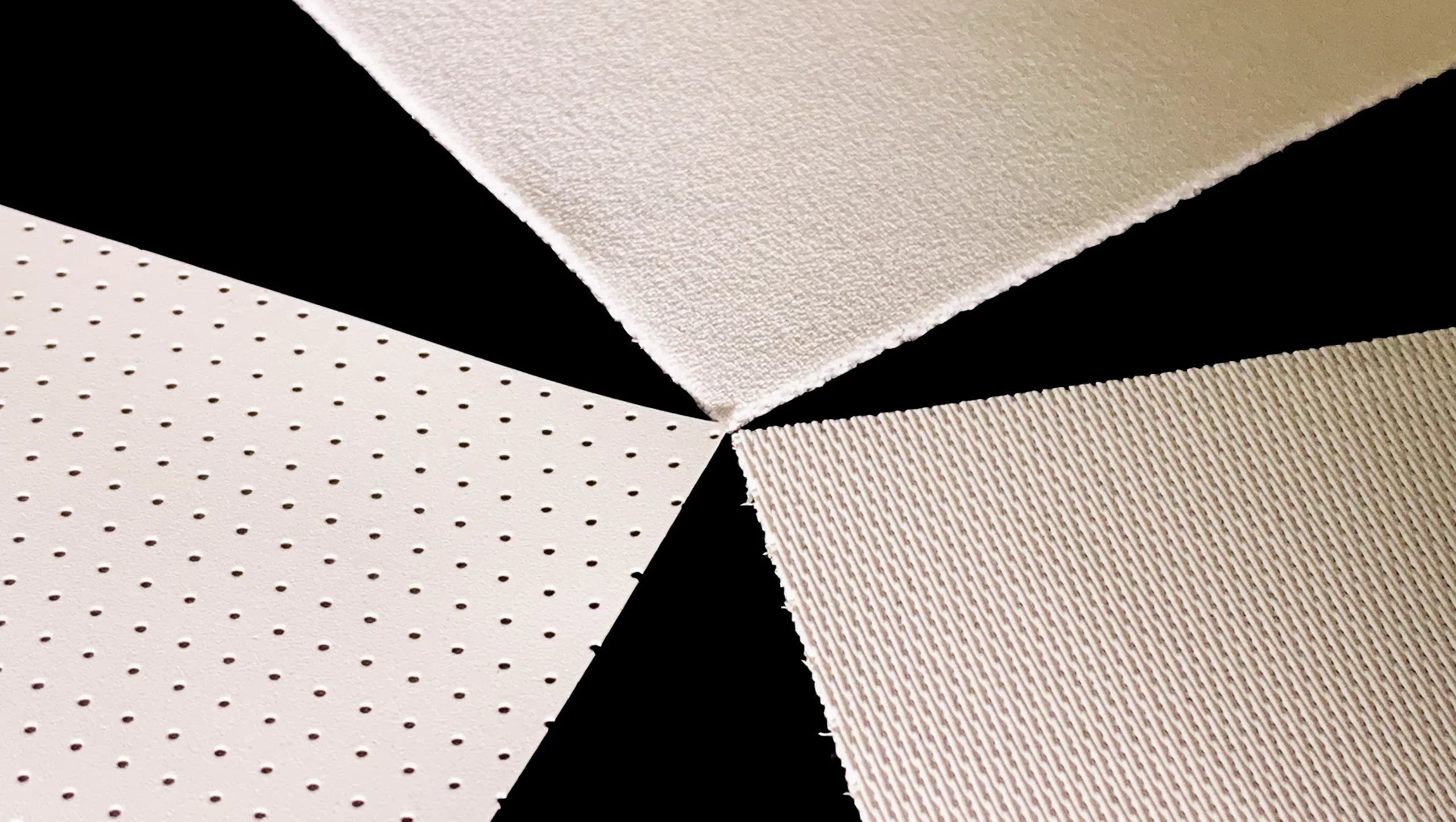
ULTIMATE SHARPNESS

This is an actual side-by-side comparison of a non-AT PVC-based projection screen. The unique patented buildup of the v6 and the v7 UltraWeave emulates the randomised surface coating and consequently the sharpness of a regular (non-transparent) screen.
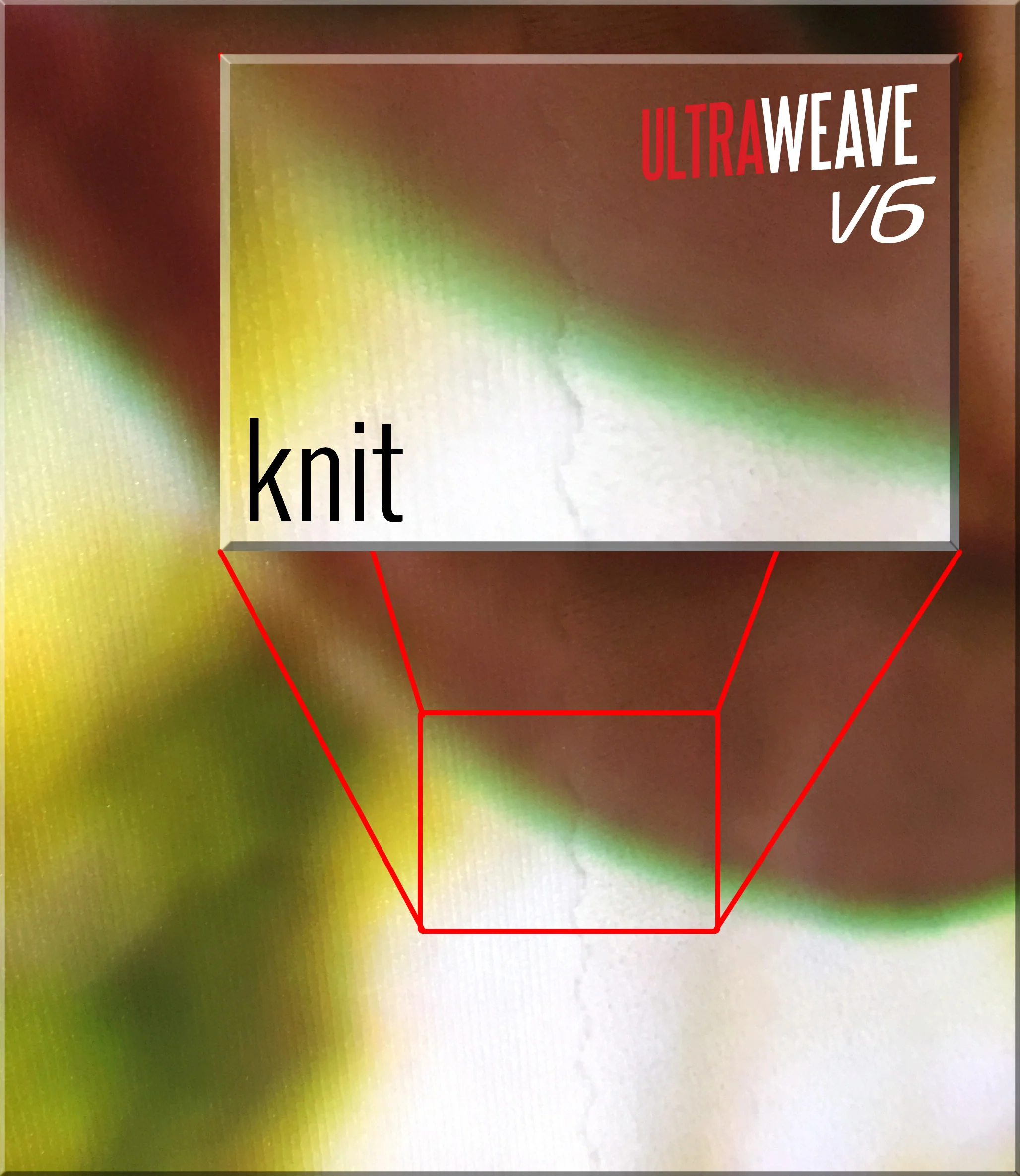
The above image compares the v6 to a random custom designed single reflective layered knitted fabric, which is what we used for our 3. generation fabrics back in 2009 as well. However, in order to increase sharpness, from our 5. generation onwards, we added the now patented ultra fine front randomly woven layer, and rather used the knitted fabrics as the second (and third for the v7) reflective as well as a black backing layer, combining the sharpness and density of the weave AND the acoustical transparency of the knit. Although knitted fabrics are quite good in both structural density and acoustical transparency, the fact remains that light blooming / spill via the knitted “fluffy” cavities reduce sharpness quite significantly. Edges appear more blurred and details simply “wash out”. Maximum reflected sharpness will become increasingly important moving forward as 4K, 8K and even higher resolutions become available. In other words, the patented design of the v6 and v7 offers The Best of Two Worlds – and consequently maximum sharpness and reference acoustical transparency.
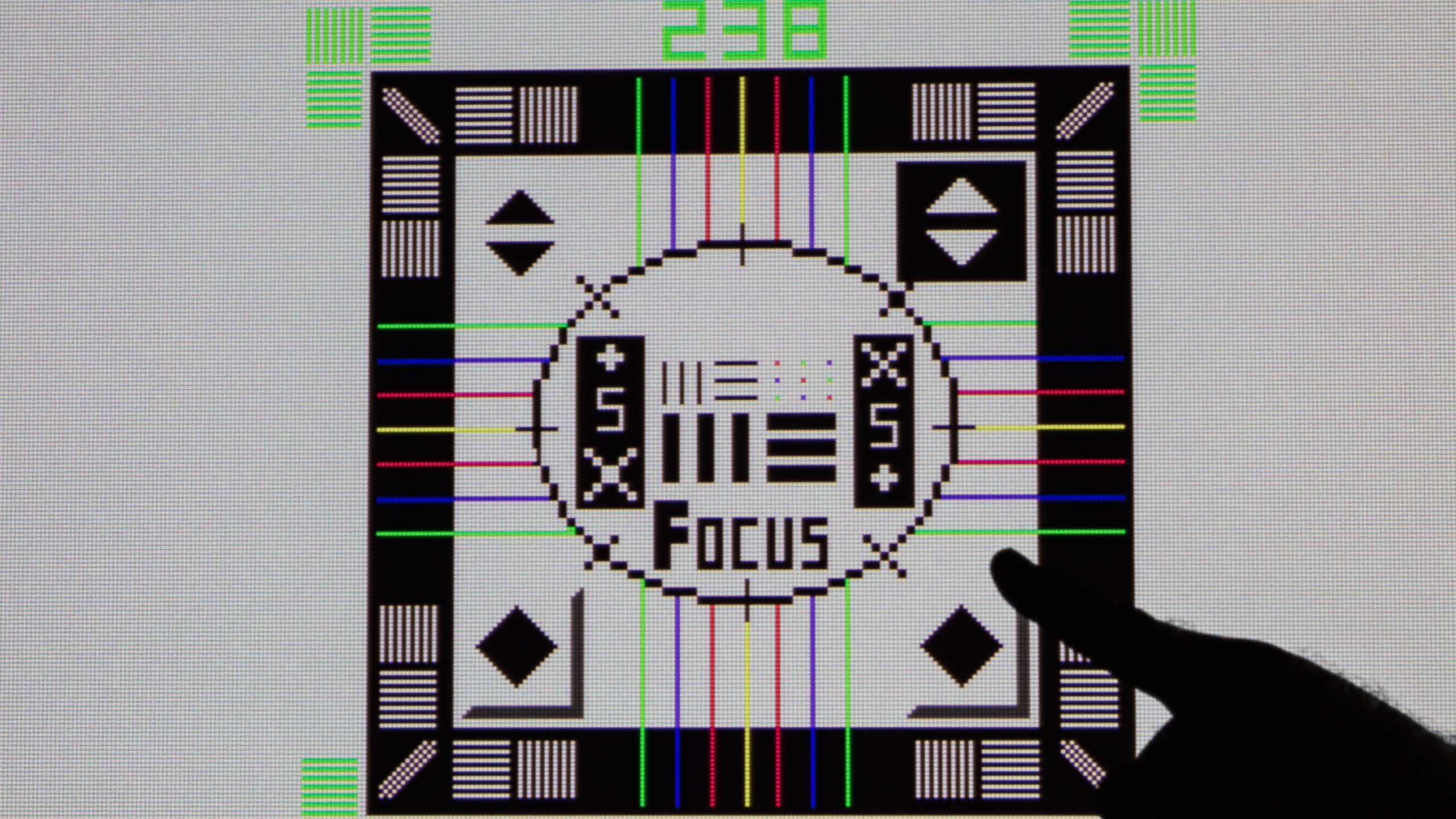
This picture of the v6 is taken by one of our valued customers in Germany, w.mayer, depicting the extremely sharp reflection from his Barco Thor15.000 lumen 6P 3-chip DLP laser (please click the image for a larger, 4K, preview). Quote from w.mayer;
“When you have a fabric screen that not show the pixels this material soften the picture to some degree for sure. This v6 material was the first that not do it! It act like a conventional screen so it not decrease at all details and sharpness and not soften the picture. This is “to my knowledge” the first fabric that act this way! WOW!”
Read more here: http://dci-forum.com/d-cinema-hi-end-cinema-home/11/barco-thor-4k-6p-residential-laser-projector-best-world/1710/msg5259;topicseen#msg5259.
INTEGRATED BLACK BACKING

The unique buildup of the UltraWeave includes an integrated black (custom knit highly AT design) backing.
The bonded nature secures that no blooming effect becomes apparent, as even the slightest distance between the layers, a common issue when manually attaching black backing to regular woven or knitted fabrics, will reduce both contrast and overall sharpness especially apparent on bright objects in dark surroundings by introducing light bleeding.
In addition, which is very important for the DIYers as well as the baffle wall installations, stray light is effectively taken care of, so that objects in the back of the screen, such as wooden studs, speakers etc., will not be visible through the fabric.

Example of how blooming appears on typical highly lit objects towards a dark background. Even the slightest distance between the reflective layer and the black backing might introduce this issue. The UltraWeave is perfectly factory bonded and will never produce this artefact on its own merit.
ACOUSTICAL TRANSPARENCY LEVELS
The UltraWeave v5-v7 achieves its reference acoustical transparency levels by combining a patented layout of woven and knitted layers. The woven ultra-fine front layer provides structural sharpness, and is highly audiotransparent due to the virtue of being extremely thin, while the remaining reflective knitted layers adds brightness while also allowing air (sound) to pass very efficiently.
Although we have modified and perfected each layer to accommodate the highest possible audio transparency on the v7, adding another reflective layer does impact the acoustical blockage levels to some degree. The UltraWeave v6 will remain our reference in terms of acoustical transparency, averaging at a record low 1,5dB blockage. The v7 is still what we consider highly audiotransparent, averaging at 3,3dB. From our perspective, the v7 balances the audio and video aspect quite elegantly.
Compared to other higher gain woven screens or certainly perforated PVC screens this level is still highly competitive, especially when taken into consideration it includes our integrated black backing.
The woven screen fabric used in our gain benchmark comparison measured more than 5dB peak drop without black backing that normally adds another 1-2dB. 6-7dB drop is quite hard to compensate for even using extensive amounts of equalisation.
Other higher gain woven screens might block less of the audio than the example we ran these comparisons to, but in all the cases we have observed, higher gain is then obtained by adding a more reflective coating to the threads (as opposed to simply tightening the weave like is the case for the fabric we have tested in our comparison, which remains quite matte) used in weaving the fabric causing shimmering and in reality a non-matte / non-unity gain image basis.
A perforated PVC screen has even greater audio blockage, ranging from 7 – >10dB.
The v6 and the v7 will be sold parallell, whereas your personal priorities, screen size, projection system and overall audio setup would be the basis of what makes out your dream screen. Please do not hesitate contacting us for advice!





